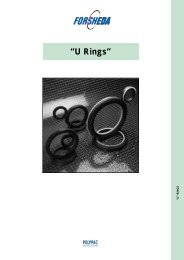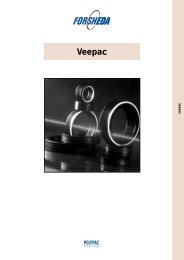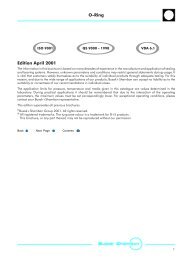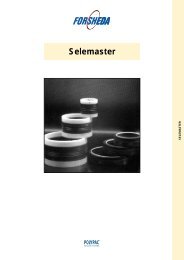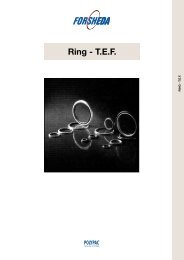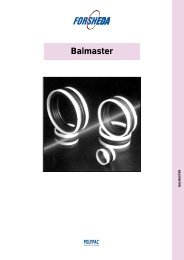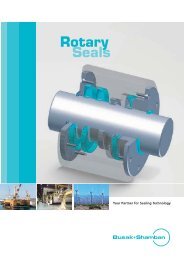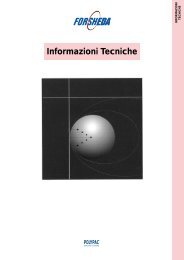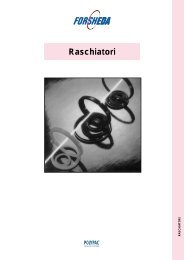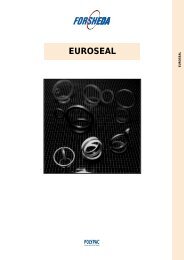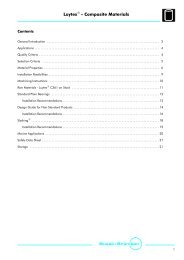You also want an ePaper? Increase the reach of your titles
YUMPU automatically turns print PDFs into web optimized ePapers that Google loves.
<strong>Turc<strong>it</strong>e</strong> R -B Slydway R 1<br />
Contents<br />
General ................................................................................... 2<br />
Design Instructions .......................................................................... 5<br />
Installation Instructions ....................................................................... 8<br />
Qual<strong>it</strong>y Cr<strong>it</strong>eria ............................................................................. 11<br />
ISO 9001 ISO 9002<br />
The information in this brochure is based on many decades of experience in the manufacture and application of sealing<br />
and sliding systems. However, unknown parameters and cond<strong>it</strong>ions may restrict general statements during usage. It is v<strong>it</strong>al<br />
that customers satisfy themselves as to the su<strong>it</strong>abil<strong>it</strong>y of individual products through adequate testing. For this reason, and<br />
due to the wide range of applications of our products, Busak+Shamban can accept no liabil<strong>it</strong>y as to the su<strong>it</strong>abil<strong>it</strong>y or<br />
correctness of our recommendations in individual cases.<br />
The application lim<strong>it</strong>s for pressure, temperature and speed given in this catalogue are maximum values determined in the<br />
laboratory. During practical applications <strong>it</strong> should be remembered that due to the interaction of the operating parameters,<br />
the maximum values must be set correspondingly lower. For exceptional operating cond<strong>it</strong>ions, please contact your<br />
Busak+Shamban representative.<br />
This ed<strong>it</strong>ion supersedes all previous brochures.<br />
e Busak+Shamban Group 2000. All rights reserved.<br />
R All registered trademarks. The turquoise colour is a trademark for B+S products.<br />
This brochure, or any part thereof, may not be reproduced w<strong>it</strong>hout our permission.<br />
*KI= 5D=>=
<strong>Turc<strong>it</strong>e</strong> R -B Slydway R<br />
General<br />
<strong>Turc<strong>it</strong>e</strong> R -B Slydway R is a high performance thermoplastic<br />
material for use on linear bearing application as found on<br />
the guideways of machine tools and other linear bearing<br />
applications.<br />
Guideways on machine tools ensure the exact direction of<br />
motion of components such as slides, sleeves, quills,<br />
plungers, etc. At the same time, guideways must bear the<br />
weight of the guided components and workpieces and absorb<br />
the machining forces w<strong>it</strong>hout deformation.<br />
This places cr<strong>it</strong>ical demands on the machine tool guideways:<br />
- high pos<strong>it</strong>ional accuracy and repeatabil<strong>it</strong>y of the working<br />
movements<br />
- high performance over many years<br />
- low production costs<br />
- low friction w<strong>it</strong>hout stick-slip as a precond<strong>it</strong>ion for pos<strong>it</strong>ional<br />
accuracy at differing veloc<strong>it</strong>ies<br />
- low wear, even in the event of poor or failed lubrication<br />
- backlash-free or minimum backlash for high repeatabil<strong>it</strong>y<br />
even under load<br />
- good damping behaviour even w<strong>it</strong>h interrupted cutting<br />
operations to minimize chatter.<br />
<strong>Turc<strong>it</strong>e</strong> R -B Slydway R has been well proven worldwide for<br />
many years in many sectors of machine tool and other<br />
heavy duty engineering industries (see Figure 1).<br />
<strong>Turc<strong>it</strong>e</strong> R -B Slydway R<br />
Milling Machining Drilling Grinding<br />
machines<br />
centres<br />
machines<br />
machines<br />
Lathes<br />
Saws<br />
Other machine<br />
tools<br />
accessories<br />
Bridge<br />
support<br />
Skids<br />
Construction/<br />
civil engineering<br />
Pipe and cable<br />
expansion<br />
support<br />
Product<br />
guides<br />
Maintenance<br />
+<br />
Refurbishment<br />
Figure 1<br />
Fields of Application for <strong>Turc<strong>it</strong>e</strong> R -B Slydway R<br />
2<br />
*KI= 5D=>=
<strong>Turc<strong>it</strong>e</strong> R -B Slydway R 3<br />
Application<br />
Slydway R can be used in a wide variety of applications.<br />
The application examples show forms of sliding slydways<br />
coated w<strong>it</strong>h <strong>Turc<strong>it</strong>e</strong> R already in use in in the machine tool<br />
industry (figure 2 on page 4).<br />
Slydway R is also applicable to other heavy duty linear<br />
bearings in the construction or civil engineering markets<br />
including bridge supports, skids, pipe or cable expansion<br />
supports, telescopic arms or any other linear application.<br />
Slydway R is normally bonded to the moving surface only<br />
of a linear bearing application. It is subsequently finish<br />
machined by milling, grinding and/or scraping to provide<br />
a su<strong>it</strong>able counterface to the cast iron, steel or other static<br />
face.<br />
Designs<br />
Slydway R meets the modern demands made by different<br />
guide systems and dimensions. It is available in thicknesses<br />
of 1.0 to 6 mm and widths up to 600 mm. It can be supplied<br />
cut to the specified length or as off-the-roll material.<br />
Table I, page 10, shows the standard sizes available.<br />
Slydway R is especially applicable to the refurbishment of<br />
worn machine tools. Worn linear bearings can be<br />
machined back and brought to the original working tool<br />
heights and centre lines by the application of Slydway R<br />
material of su<strong>it</strong>able thickness.<br />
Characteristics<br />
Slydway R is manufactured from the specially developed<br />
high-performance thermoplastic <strong>Turc<strong>it</strong>e</strong> R and modified for<br />
the special requirements for linear bearing applications. In<br />
order to achieve good adhesion when bonding w<strong>it</strong>h the<br />
machine components, the surface is chemically treated.<br />
Advantages<br />
- low friction, no jamming, no stick-slip, particularly at<br />
low sliding speeds<br />
- good mechanical properties, wear-resistant and dimensionally<br />
stable<br />
- safety against dry running in the event of poor or no<br />
lubrication<br />
- high wear resistance, thus ensuring a long service life<br />
- good emergency running properties, no tendency to<br />
seize<br />
- dampsandabsorbsvibrations<br />
- impervious to soiling and moisture<br />
- chemically resistant to aggressive cooling lubricants<br />
- dimensions available from stock, simple and cost-effective<br />
handling.<br />
Material Characteristics<br />
Material No.<br />
Colour in etched<br />
delivery cond<strong>it</strong>ion:<br />
Colour after<br />
mechanical machining:<br />
TB<br />
medium to dark brown<br />
green-grey<br />
Water absorption: < 0.01 %<br />
Linear coefficient<br />
of expansion: 6 x 10 -5 1/K<br />
Thermal conductiv<strong>it</strong>y<br />
at 20 C:<br />
0.8 W/m S K<br />
Max. pressure load<br />
for 1% deformation: 930 N/cm 2<br />
Hardness:<br />
60 5ShoreD<br />
Modulus of elastic<strong>it</strong>y: 1.000 N/mm 2<br />
Chemical resistance:<br />
Material TB has a very good chemical resistance and is<br />
resistant to coolants, clear coolants and lubricants.<br />
Storage Instructions<br />
Slydway R should be stored in dry rooms protected from<br />
light at room temperature for not more than two years.<br />
Before further processing Slydway R must be cleaned. See<br />
chapter ”Installation instructions”.<br />
*KI= 5D=>=
<strong>Turc<strong>it</strong>e</strong> R -B Slydway R<br />
Designs<br />
Flat tapered Guideway<br />
Dovetail Guideway<br />
V-Guideway<br />
Flat Guideway<br />
Double V-Guideway<br />
Flat V-Guideway<br />
Figure 2<br />
Slydway R installation examples<br />
4<br />
*KI= 5D=>=
<strong>Turc<strong>it</strong>e</strong> R -B Slydway R 5<br />
Design Instructions<br />
Load and Contact Deformation<br />
In conjunction w<strong>it</strong>h the contact deformation, the load is of<br />
great significance for the operating precision of the linear<br />
bearing. The surface pressures for Slydway R in machine<br />
tool construction are generally selected between 20 and<br />
200 N/cm 2.<br />
The load-carrying capac<strong>it</strong>y is dependent on the thickness<br />
of the bearing material and the surface roughness.<br />
Figure 3 shows the contact deformation as a function of<br />
different material thicknesses t for slydways w<strong>it</strong>h a surface<br />
roughness of R a =0.6m. As can be seen from the diagram,<br />
Slydway R can be subjected to even more than the<br />
optimum range.<br />
W<strong>it</strong>hin the working range depicted, the coefficient of friction<br />
of the <strong>Turc<strong>it</strong>e</strong> R TB material remains practically unchanged.<br />
Surface Roughness<br />
<strong>Turc<strong>it</strong>e</strong> R -B sliding surfaces can be finish machined by<br />
milling, grinding and/or scraping. The surface qual<strong>it</strong>y<br />
should be R a =0.6m. Minor deviations such as shown<br />
in figure 4 have an insignificant effect on the friction behaviour.<br />
However, w<strong>it</strong>h greater surface roughnesses the contact<br />
deformation and wear would increase. An insufficient<br />
surface roughness influences the sliding behaviour as the<br />
sliding surfaces stick together (adhesion).<br />
Figure 4 shows an optimum surface roughness range<br />
which should be achieved during final machining of the<br />
surface.<br />
7<br />
m<br />
16<br />
m<br />
12<br />
Surface roughness<br />
Ra = 0.6<br />
m<br />
t=2.5mm<br />
t=1.5mm<br />
Contact deformation<br />
4<br />
2<br />
0<br />
Ra<br />
0.8<br />
0.6<br />
0.2<br />
0 100 200 300 N/cm 2 500<br />
10<br />
Surface pressure<br />
Deformation<br />
8<br />
6<br />
4<br />
2<br />
Optimum range<br />
t=1.0mm<br />
Figure 4<br />
Deformation as a function of surface pressure<br />
for different surface roughness<br />
0<br />
0 100 200 300 400 500 600 700 N/cm2<br />
900<br />
Surface pressure<br />
Figure 3<br />
Deformation as a function of surface pressure<br />
and thickness t of the <strong>Turc<strong>it</strong>e</strong>-B Slydway R<br />
material<br />
*KI= 5D=>=
<strong>Turc<strong>it</strong>e</strong> R -B Slydway R<br />
Coefficients of Friction<br />
In use Slydway R displays only a slight difference between<br />
static friction and dynamic friction, thus eliminating any<br />
stick-slip. When used in numerically controlled machines,<br />
this produces higher pos<strong>it</strong>ioning and reproduction precision.<br />
Good lubrication is of paramount importance in order to<br />
achieve a controlled level of dynamic friction.<br />
Static Friction<br />
The coefficient of static friction for a Slydway R bearing<br />
depends on the material pairing in question and on the<br />
surface roughness of the <strong>Turc<strong>it</strong>e</strong> R -B sliding surface, on the<br />
mating surface and on the lubrication.<br />
Figure 5 shows the range of static friction when using different<br />
oils. The values were determined on a scraped<br />
<strong>Turc<strong>it</strong>e</strong> R -B sliding surface w<strong>it</strong>h a surface contact pressure<br />
of 35 N/cm 2 and a surface roughness of the guide of<br />
R a =0.6m.<br />
Coefficient of dynamic friction<br />
0.06<br />
f<br />
0.04<br />
0.03<br />
0.02<br />
0.01<br />
0<br />
0.001 0.01 0.1 1.0 m/min 10<br />
Sliding Speed<br />
Coefficient of static friction<br />
0.08<br />
fo<br />
0.06<br />
0.04<br />
0.02<br />
Figure 5<br />
0<br />
Dynamic Friction<br />
1 10 100 S 1000<br />
Standstill time<br />
Range of the coefficient of static friction (fo)<br />
as a function of the standstill time when<br />
using different lubricants<br />
The dynamic friction for a Slydway R has a practically<br />
linear pattern over the whole speed range. The good<br />
material pair of <strong>Turc<strong>it</strong>e</strong> R -B and hardened steel guides can<br />
be clearly seen in the mixed friction zone. W<strong>it</strong>h a<br />
combination of a surface load of 35 N/cm 2 and a scraped<br />
<strong>Turc<strong>it</strong>e</strong> R -B surface, the coefficient of friction reaches<br />
Figure 6<br />
Range of the coefficient of dynamic friction<br />
(f) as a function of the sliding speed when<br />
using different lubricants<br />
Wear<br />
The service life and the continuous precision of a Slydway R<br />
is determined primarily by <strong>it</strong>s wear behaviour. Slydway R<br />
linear bearing are generally supplied w<strong>it</strong>h adequate<br />
lubrication.<br />
Should the lubricant supply suddenly be interrupted,<br />
Slydway R will remain functional w<strong>it</strong>h low wear even for<br />
prolonged periods due to the self-lubricating properties of<br />
the material. Very low wear rates are achieved using the<br />
combination of Slydway R and hardened mating surface.<br />
The wear behaviour is determined to a great extent by the<br />
ambient influences. It is important to protect the guides<br />
from external soiling by using covers and seals.<br />
The Slydway R has the great advantage of being able to<br />
absorb and embed small dirt particles, thus preventing<br />
immediate seizing, damage and extreme wear of the<br />
guides.<br />
f = 0.022 - 0.055.<br />
Figure 6 shows the least differences at the trans<strong>it</strong>ion to the<br />
hydrodynamic range. W<strong>it</strong>h higher surface pressures of up<br />
to 200 N/m 2 , the sliding behaviour changes only insignificantly.<br />
6<br />
*KI= 5D=>=
Start-up Phase<br />
A linear bearing application, using Slydway R should<br />
always be well lubricated during the start-up phase.<br />
During the start-up phase, very fine particles of the<br />
<strong>Turc<strong>it</strong>e</strong> R -B material are depos<strong>it</strong>ed on the mating surface.<br />
This leads to a slight shading of the metallic running<br />
surfaces. The start-up phase is then concluded w<strong>it</strong>h the<br />
smoothing phase. A very low level of friction and wear is<br />
then reached which remains essentially constant (Figure 7).<br />
The guides can then be used for continuous operation.<br />
Wear<br />
15<br />
m<br />
10<br />
5<br />
0<br />
<strong>Turc<strong>it</strong>e</strong> R -B Slydway R 7<br />
0 50 100 150 200 km 300<br />
Travel<br />
Figure 8<br />
Wear behaviour of <strong>Turc<strong>it</strong>e</strong>-B Slydway R<br />
Wear<br />
Figure 7<br />
Start-up phase<br />
Travel<br />
Smoothing<br />
Operating phase<br />
Wear in operating<br />
cond<strong>it</strong>ion<br />
Start-up wear<br />
Wear as a function of the operating cond<strong>it</strong>ion<br />
Sliding Wear<br />
Slydway R are set backlash-free or even slightly preloaded,<br />
thus ensuring a very high continuous precision even over<br />
many years. The sliding behaviour is then determined<br />
primarily by the lubricant and the surface finish.<br />
Figure 8 shows the wear behaviour of a scraped Slydway R<br />
w<strong>it</strong>h a mean load of 50 N/cm 2 w<strong>it</strong>h adequate lubrication.<br />
Mating Surfaces<br />
In order to ensure a long service life, demands must also<br />
be made on the surface finish of the mating surface. The<br />
following values are recommended:<br />
for steel R a = 0.2 to 0.4 m<br />
R z = 1.6 to 3.2 m<br />
R max = 2.5 to 5.0 m<br />
for grey cast iron R a = 0.2 to 0.8 m<br />
R z = 1.6 to 6.3 m<br />
R max = 2.5 to 10.0 m<br />
(These figures are only valid for <strong>Turc<strong>it</strong>e</strong> R -B Slydway R<br />
applications).<br />
Steel and cast iron are frequently used as materials for<br />
mating surfaces. Hardened mating surfaces are generally<br />
preferred for precision guides subject to high loads. In<br />
practice, hardnesses of approx. 60 HRc for steel and<br />
approx. 240 HB for cast iron have been found to be effective.<br />
These sliding surfaces are not normally subject to any<br />
wear. For guide systems subject to less wear, unhardened<br />
and wear-resistant mating surfaces can also be used.<br />
Mating surfaces of bronze, aluminium (untreated) or<br />
plastics are not su<strong>it</strong>able for use w<strong>it</strong>h Slydway R .<br />
Temperature<br />
Thetemperatureattheslidingsurfacesshouldbekeptas<br />
constant as possible. In the event of elevated temperatures,<br />
an adequate heat dissipation must be assured by<br />
means of lubrication.<br />
*KI= 5D=>=
<strong>Turc<strong>it</strong>e</strong> R -B Slydway R<br />
Installation Instructions<br />
Securing the Slydway R Material<br />
Slydway R material is secured by bonding. Performed w<strong>it</strong>h<br />
the necessary care, bonding is a reliable and inexpensive<br />
securing method.<br />
Surface Preparation:<br />
The preparation of the parts to be bonded together is of ultimate<br />
importance for achieving a good bond.<br />
Machining of the adhesive surface is crucial for optimum<br />
bonding of Slydway R . To a certain extent, the surface<br />
roughness assists the bonding abil<strong>it</strong>y of the adhesive.<br />
Surface Roughness R a =0.8to3.2m.<br />
Add<strong>it</strong>ional possibil<strong>it</strong>ies of roughening the surface are sandblasting<br />
and rubbing w<strong>it</strong>h emery cloth (grain size: 100).<br />
Cleaning the Bonding Surface<br />
Before applying the adhesive, the bonding surfaces must<br />
be cleaned thoroughly and freed from oil, grease, dust<br />
and rust. Impur<strong>it</strong>ies can be removed by washing w<strong>it</strong>h a<br />
commercially available degreasing agent such as acetone,<br />
etc. When refurbishing machine tools w<strong>it</strong>h cast iron<br />
surfaces, flame treating of the porous surface to remove<br />
embedded oil depos<strong>it</strong>s may be beneficial.<br />
Machining<br />
Slydway R can be machined mechanically after the bonding<br />
point has set. <strong>Turc<strong>it</strong>e</strong> R -B materials can be machined<br />
qu<strong>it</strong>e easily.<br />
Machining Methods<br />
Precision Milling<br />
For precision milling tools such as face cutters w<strong>it</strong>h one or<br />
more cutting edges made from high-speed steel, tungsten<br />
carbide or ceramic materials can be used.<br />
Surface qual<strong>it</strong>ies such as those achievable when grinding<br />
can be produced w<strong>it</strong>h high cutting rates (up to 800 m/min)<br />
and low feed rates. In order to achieve a good surface<br />
finish, two cuts w<strong>it</strong>h small chip thicknesses are to be<br />
recommended.<br />
No cooling is generally needed when milling Slydway R .<br />
Bonding the Slydway R<br />
Slydway R should be bonded in a clean environment and<br />
at normal room temperature, ideally 20 _ C. A good<br />
two-component epoxy-resin adhesive is used. After<br />
mixing, apply the adhesive components to both parts to<br />
be bonded using a serrated spatula. Place the Slydway R<br />
material onto the surfaces to be joined and load them uniformly<br />
to eliminate any air and excess adhesive.<br />
The parts should not shifted relative to one another during<br />
the prescribed hardening time. Finish machining of the<br />
Slydway R surface is carried out after the adhesive has<br />
hardened. We recommend the use of a Busak+Shamban<br />
two-component epoxy-resin adhesive.<br />
Please send for our detailed bonding instructions.<br />
Safety Precautions<br />
When bonding Slydway R w<strong>it</strong>h epoxy-resin adhesives, the<br />
safety precautions in accordance w<strong>it</strong>h DIN 52900 must be<br />
observed. The working areas should be adequately ventilated.<br />
Smoking should be avoided during bonding and<br />
machining.<br />
Figure 9<br />
Precision Milling<br />
8<br />
*KI= 5D=>=
<strong>Turc<strong>it</strong>e</strong> R -B Slydway R 9<br />
Grinding<br />
Grinding wheels w<strong>it</strong>h normal abrasives (e.g. special fused<br />
alumina, silicon carbide) can be used for grinding. The<br />
grinding wheels should have a medium grain (36) and a<br />
low hardness (I). The method of bonding can be ceramic<br />
(Ke) or may contain synthetic resin (Ba). Wet grinding is<br />
always recommended for grinding of Slydway R . The<br />
coolant dissipates the heat of grinding and provides a<br />
better surface finish. Grinding wastes have to be removed.<br />
Scraping<br />
Milled and ground surfaces can be remachined by scraping<br />
to improve the surface qual<strong>it</strong>y and dimensional accuracy.<br />
Only sharply ground scraping tools should be used.<br />
Scraping can be performed manually or w<strong>it</strong>h a scraping<br />
machine. A grade of 2 is required for a precision surface,<br />
corresponding to 2 to 3 points per cm 2 . A perfectly<br />
scraped or patterned surface enhances the tribological<br />
properties of the guides.<br />
Figure 10<br />
Grinding<br />
Figure 11<br />
Scraping<br />
Oil Grooves<br />
Slydway R can be machined to incorporate oil or<br />
lubrication groove patterns. The configuration of the<br />
groove is optional. Is is best to mill the oil grooves into the<br />
material to a depth of 0.5 - 0.6 mm. Milling completely<br />
through the material into the metal saddle is not<br />
recommended. For any pattern chosen, <strong>it</strong> is extremely<br />
important that the milled grooves maintain a generous,<br />
smooth radius which blends the top of the groove back to<br />
the surface of the material w<strong>it</strong>hout creating any sharp<br />
edges. Oil grooves should never be machined closer than<br />
6mmtotheedge and15mmfromtheendsofthe<br />
bearing material.<br />
*KI= 5D=>=
<strong>Turc<strong>it</strong>e</strong> R -B Slydway R<br />
Dimensions / Ordering Example<br />
Slydway R is available cut to length or off-the-roll.<br />
Standard strip thicknesses are 1.5 and 2.5 mm. Other<br />
thicknesses are available on request.<br />
The standard strip widths are shown in Table I. Other<br />
widths up to 600 mm can also be supplied.<br />
For the standard dimensions, please use the order numbers<br />
from Table I. The desired length (m) has to be stated<br />
w<strong>it</strong>h the order number.<br />
Adhesive for Slydway R<br />
We recommend the use of a packaged un<strong>it</strong> comprising:<br />
50 g resin and 20 g accelerator Order No. XZZS000006.<br />
The quant<strong>it</strong>y supplied is sufficient for bonding approx.<br />
0.25 m 2 of Slydway R .<br />
Table I<br />
Standard Dimensions / Order Nos.<br />
Strip thickness 1.5 mm<br />
Strip length 23 m<br />
Strip<br />
width<br />
-mm-<br />
Order No.<br />
Strip thickness 2.5 mm<br />
Strip length 13.5 m<br />
Strip<br />
width<br />
-mm-<br />
Order No<br />
10 GLB500010-TB 10 GLC500010-TB<br />
15 GLB500015-TB 15 GLC500015-TB<br />
20 GLB500020-TB 20 GLC500020-TB<br />
25 GLB500025-TB 25 GLC500025-TB<br />
30 GLB500030-TB 30 GLC500030-TB<br />
35 GLB500035-TB 35 GLC500035-TB<br />
40 GLB500040-TB 40 GLC500040-TB<br />
45 GLB500045-TB 45 GLC500045-TB<br />
50 GLB500050-TB 50 GLC500050-TB<br />
60 GLB500060-TB 60 GLC500060-TB<br />
70 GLB500070-TB 70 GLC500070-TB<br />
80 GLB500080-TB 80 GLC500080-TB<br />
90 GLB500090-TB 90 GLC500090-TB<br />
100 GLB500100-TB 100 GLC500100-TB<br />
125 GLB500125-TB 125 GLC500125-TB<br />
150 GLB500150-TB 150 GLC500150-TB<br />
Ordering Example<br />
Order No. GLB500 035 - TB<br />
Series No.<br />
Width<br />
Qual<strong>it</strong>y Index (Standard)<br />
Material No. (Standard)<br />
10<br />
*KI= 5D=>=
Qual<strong>it</strong>y Cr<strong>it</strong>eria<br />
The cost-effective use of seals and bearings is highly<br />
influenced by the qual<strong>it</strong>y cr<strong>it</strong>eria applied in production.<br />
Seals and bearings manufactured by Busak+Shamban<br />
are continuously mon<strong>it</strong>ored according to strict qual<strong>it</strong>y<br />
standards from material acquis<strong>it</strong>ion through to delivery.<br />
Certification of our production plants in accordance w<strong>it</strong>h<br />
international standards EN ISO 9000 meets the specific<br />
requirements for qual<strong>it</strong>y control and management of<br />
purchasing, production and marketing functions.<br />
Our qual<strong>it</strong>y policy is consistently controlled by strict<br />
procedures and guidelines which are implemented w<strong>it</strong>hin<br />
all strategic areas of the company.<br />
All testing of materials and products is performed in<br />
accordance w<strong>it</strong>h accepted test standards and<br />
specifications, e.g. random sample testing in accordance<br />
w<strong>it</strong>h DIN ISO 2859 part 1/ANSI/ASQC Z 1.4-1993/<br />
MIL-STD- 105 E. Inspection specifications correspond to<br />
standards applicable to individual product groups (e.g.<br />
for O-Rings: ISO 3601/DIN 3771).<br />
Our sealing materials are produced free of<br />
chlorofluorinated hydrocarbons and carcinogenic elements.<br />
The 10 th dig<strong>it</strong> of our article number defines the qual<strong>it</strong>y<br />
characteristics of the part. A hyphen indicates compliance<br />
w<strong>it</strong>h standard qual<strong>it</strong>y cr<strong>it</strong>eria outlined in this catalogue.<br />
Customer-specific requirements are indicated by a<br />
different symbol in this pos<strong>it</strong>ion. Customers who require<br />
special qual<strong>it</strong>y cr<strong>it</strong>eria should contact their local<br />
Busak+Shamban sales office for assistance. We have<br />
experience to meet all customer qual<strong>it</strong>y requirements.<br />
<strong>Turc<strong>it</strong>e</strong> R -B Slydway R<br />
*KI= 5D=>=<br />
11



